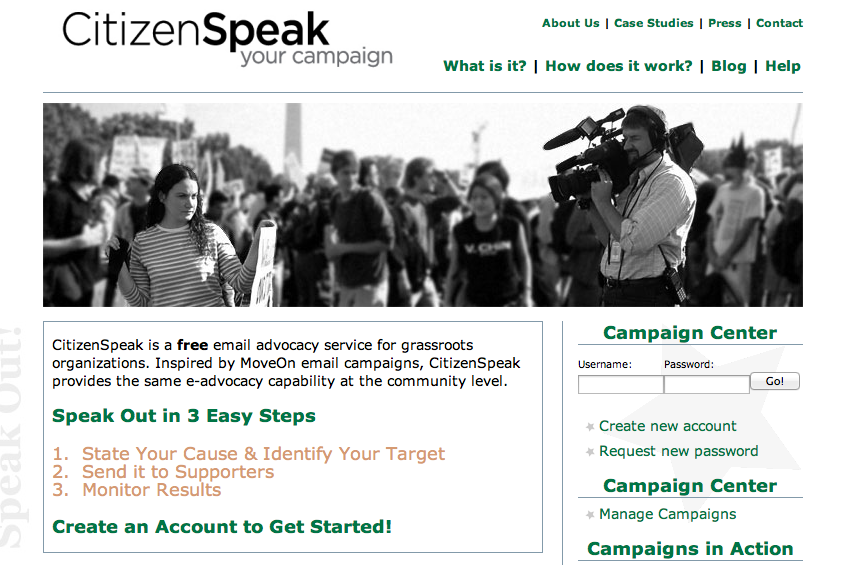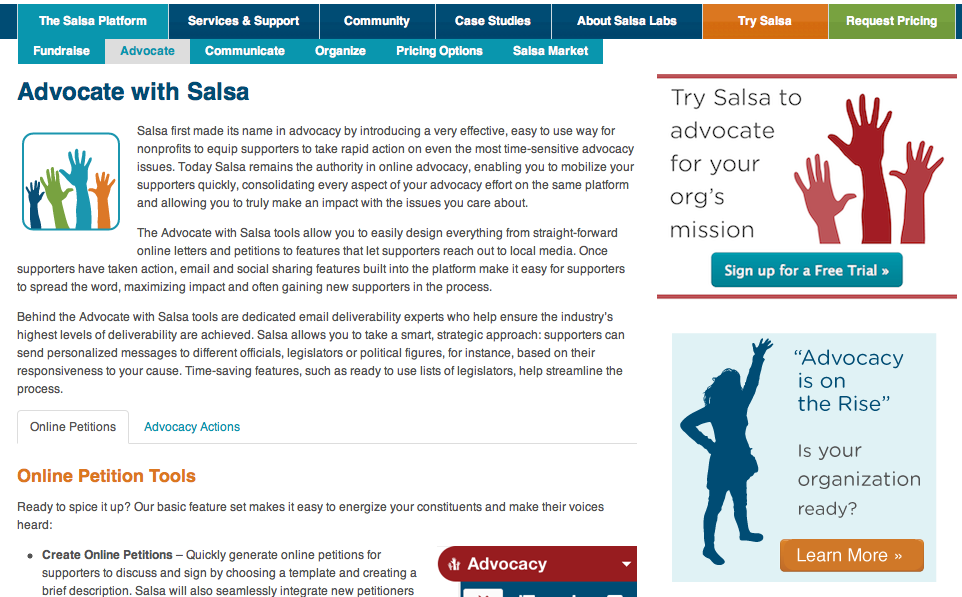
Target audience: Advocacy and cause organizations, nonprofits, foundations, NGOs, social enterprises, political organizations, educators, journalists, general public.
Guest post by Kyle Henri Andre
Idealware
Advocacy organizations often encourage their grassroots supporters to influence politicians and corporations using different methods, from promoting a cause or opposing legislation to challenging ad campaigns or policies. A large display of public opinion can have a powerful message, and advocacy groups often help to focus and channel this support to make the most impact.
This has been traditionally done with mail. The sheer bulk of hundreds or thousands of letters was a strong visual stand-in for the people behind the cause. Today the tactic hasn’t changed, but the message is more likely to be delivered by email, telephone or social media, and the physical presence of the message replaced by the easy, constant barrage of communications.
Let’s look at a few of the tools available to help advocacy groups direct grassroots communications to a target.
Email-based tools
While once a strong alternative to physically mailing letters, high-volume email campaigns have become more difficult at the national level. Most Congressional offices now use web forms and other filters to restrict the flow of email to their inboxes, minimizing their impact. The majority of midrange and higher-end tools are able to navigate these roadblocks, but it’s a game of cat and mouse; as the email tools become more effective, so too do the defenses.
On the other hand, state and local politicians have lower email traffic and therefore tend to have fewer restrictions on the emails they receive. This makes them more effective targets. Corporations also tend to be more vulnerable to such efforts than Congress, and are more sensitive to attacks on their brand — and, in turn, more responsive to a campaign.
Web forms, filters and other obstacles do more than limit the volume of email that makes it to an inbox — they also request contact information. By requiring a street address, zip code or district, they make it possible to verify that the email is coming from a real person who’s a constituent of the targeted legislator. There’s growing concern among advocacy organizations that email is no longer the effective tool it once was, but a number of software applications can help with such campaigns.
Free and lower-cost tools

CitizenSpeak: The free tool CitizenSpeak provides a simple, straightforward method for advocacy organizations to create an email and then allow supporters to modify, personalize and send the message. Organizations must provide a single target email address, however, which makes it difficult to spread an email campaign across multiple voting districts. CitizenSpeak emails will not automatically navigate through web forms or other filters, making it better suited to a campaign targeting state or local politicians, or corporations.

POPVOX: POPVOX matches your supporters to their representatives and verifies them by name and address. Approved users can then support or oppose legislation by selecting from upcoming bills, or send messages to their representatives. (See our article PopVox: How to advocate your cause in Congress.)
For larger organizations

Salsa: Salsa offers email advocacy, list management, petition functionality, website content management features and survey capabilities. Email blasting and online donations are also available for additional fees. The package is quite flexible, and can be seamlessly integrated into a website, but you’ll need substantial HTML expertise to set it up. (See our article How Salsa Labs enables positive social action.)
For those with expansive needs and more substantial budgets, a number of high-end tools provide strong, advanced features — for a cost. These tools begin at around $1,000 per month. For instance, Blackbaud Sphere and Convio are fairly widely used among large advocacy organizations and combine advanced email advocacy capability with robust online features and constituent tracking. Several newer options from major advocacy consulting firms include ActionKit, put out by We Also Walk Dogs (which is closely associated with MoveOn.org), and a built-to-order offering by Blue State Digital.
Using your existing tools
If your targets aren’t hiding behind a filter or other roadblock, and you’re willing to get a little creative technically, you may be able to adapt one of the tools already used by your organization to send your message.
Most website Content Management Systems (CMSs) — like Drupal, Joomla, WordPress or Plone — provide the ability to create email website forms. You could pre-populate the form with the text of an email for supporters to modify or personalize, a method very similar to CitizenSpeak in functionality. This option has the advantage of being easily branded for your organization, and is fairly easy to implement. However, it relies on your CMS’s broadcast email functionality, which might be less reliable than other options included here.
If you’re running a national advocacy campaign, you might want to help your supporters to identify and contact their appropriate representative through your website. Cicero API, from Azavea, allows you to connect your supporters to their representatives when they enter their zip code. You’ll need a programmer to help you implement it.
Other campaign methods
Email is just one method being used to replace the traditional snail-mail campaigns. Telephone-based efforts and social media can both work well in different circumstances.
Click-to-call telephone tools
Congress has typically been more responsive to phone calls than emails, and staffers are more likely to answer a phone than reply to — or even read — an email. Technology is emerging that will allow your supporters to make a phone call by entering their phone number on your website and clicking a button. The tool will then call their phone to connect them with your campaign target. There’s no well-known software that’s available out-of-the box to provide this functionality, but consider Twilio if you’re able to work with a program to implement an application programming interface, or API, which is basically a way for websites to access data from another site.
Social media tools
As politicians and corporations have adopted social media, those channels have emerged as locations for advocacy campaigns. Social media channels like Facebook and Twitter are public locations that allow for more public exposure than calling or emailing a congressional office. Many national politicians seem to be embracing Twitter, in particular, and many national and multinational corporations and brands have similarly taken to both Twitter and Facebook.
Remember, because corporations have more at stake to protect the image of their brand, they are more likely to respond to campaigns. While your supporters can take action directly on Facebook, or using hashtags and retweets on Twitter, some purpose-built tools have emerged to help with these efforts. For instance, Act.ly provides a free tool that uses Twitter to target politicians and corporations.
Whatever method you use, advocacy campaigns can be an effective way to show the support for a particular piece of legislation or policy or a similar cause. There are enough different ways available to spread the message that it’s worth taking the time to choose the one that best fits both your supporters and your target.
To learn about different ways of conducting petitions and pledges online, read our article, A Few Good Online Petition Tools. To learn about advocacy in the age of social media, read Influencing Public Policy in the Digital Age: The Law of Online Lobbying and Election-Related Activities.
This article originally appeared on Idealware and is republished under a Creative Commons Attribution NonCommercial No Derivatives 2.5 license.
Related
• Social Advocacy Toolkit (Socialbrite)
• Resources for social advocates (Socialbrite)
• 10 top tools for cause campaigns (Socialbrite)
• E-campaign resources (Socialbrite)
• How Salsa Labs enables positive social action (Socialbrite)
• Crowdshout: Social advocacy made simple (Socialbrite)
• Growing nonprofits and social movements with NationBuilder (Socialbrite)
• Empowered.org: Out to grow grassroots movements (Socialbrite)
• Causes reinvents itself as a campaign center (Socialbrite)








